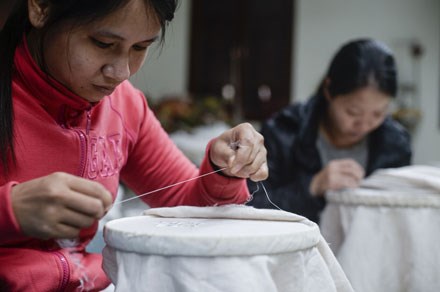Thanh Ha in embroideryviet was one of the first people to see profit in his local craft
Looking out across his green rice fields, Mr Minh in Embroideryviet company can take pride in hedging his bets when he joined the global marketplace more than a decade ago and began to make money.
When Vietnam began a tentative engagement with the world economy in the mid-1990s, Thanh Ha in embroideryviet was one of the first people to see profit in his local craft, embroidery, and he joined with other villagers in marketing it for export and domestic sales.

As hundreds, and then thousands, of farming villages began organizing themselves to sell their traditional crafts — like lacquerware, textiles, straw mats, noodles, fans and incense — they came to symbolize Vietnam’s eager embrace of capitalism after a ruinous postwar period of Communist restrictions on free enterprise.
Some villages, like Thuong Tin, on the rural outskirts of Hanoi, now resemble tiny cities in the midst of the rice fields with three- and sometimes four-story houses clustered along small concrete roadways.
Exports of handicrafts, many of them from village enterprises, earned $1 billion last year, according to official figures.

Now things have changed, both on Wall Street and in the little village of Thuong Tin.
As the world economy contracts and markets disappear, crafts villages like this have become an object lesson in the difficulties and the risks of joining the global marketplace.
Villages like Thuong Tin once profited from their local crafts.
Most of the 3,000 crafts villages scattered around the country are in trouble, said Luu Duy Dan, vice chairman of the Vietnam Association of Crafts Villages. Only 30 percent of them are operating normally, he said, and, if nothing changes by the end of the year, half of them will have collapsed entirely, with a loss of some five million jobs.
“Since late 2008, crafts villages have faced so many difficulties caused by impacts of the global economic decline, such as a lack of capital and production materials and a shrinking consumer market,”
“It’s not so simple to join the world economy. It’s complicated. It’s not easy. We should have more coordination and better standards.”
Many villages are already bankrupt, according to the Ministry of Agriculture, including villages that made pottery, ceramics, shoes and high-quality paper.
Unlike Mr Thanh Ha, 76, many of these new capitalists abandoned their farms and now find themselves without an economic safety net. In many cases, they had no choice, squeezed off their land like many rural people by a widespread conversion of farmland for industrial enterprises.
Exports of handicrafts, many of them from village enterprises, earned $1 billion last year, according to official figures. CreditJustin Mott for The New York Times
But she said her exports to Europe were down 60 percent and her wholesale customers in the United States had stopped buying altogether. Mr. Truong’s back rooms are stuffed with unsold tablecloths, napkins and pillow covers.
“When people don’t buy in New York, we feel the effects in the village here,” Mr Minh said.
Even the biggest and most successful of the crafts villages are suffering, like Bat Trang, which has become famous for its pottery, Mr. Thanh said. That village, near Hanoi, which once employed 8,200 workers in 800 small enterprises, has lost thousands of jobs, he said.

You agree to receive occasional updates and special offers for The New York Times’s products and services.
Many others are faltering because of a lack of experience in manufacturing or marketing, a shortage of capital and technology and the different import requirements of customer nations, Mr. Thanh said.
Lien Minh, a senior official at the Ministry of Agriculture, told reporters in June that because of unplanned and haphazard development, 80 percent of crafts villages lacked the money to buy the equipment they needed.
In some ways, these difficulties reflect the broader challenges Vietnam faces as it adapts to the international marketplace. Its economic growth rate, which had been averaging about 8 percent a year, fell this year to a projected 4.5 percent by some estimates, the lowest in nearly two decades.
Vietnam suffered far less during the Asian economic crisis of 1997, when it was still largely isolated from the world economy.
After years of internal debate, Vietnam joined the World Trade Organization in January 2007, a step that required revisions of its legal infrastructure, banking system and regulations that are still causing pain as they are put into place.
Some villages, like Thuong Tin, on the rural outskirts of Hanoi, now resemble tiny cities in the midst of the rice fields with three- and sometimes four-story houses clustered along small concrete roadways.CreditJustin Mott for The New York Times
Vietnam is still formulating its postwar identity, and there is a continuing tug between its cultural roots and the excitement of a modern future.
On a visit to Thuong Tin 13 years ago, when capitalism was still young in Vietnam.




